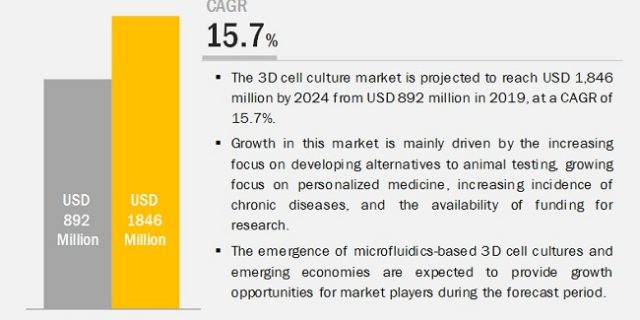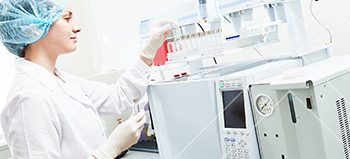
The growth of 3d cell culture market is driven mainly by the increasing
focus on developing alternatives to animal testing, growing focus on personalized
medicine, increasing incidence of chronic diseases, and the availability of
funding for research. On the other hand, the lack of infrastructure for 3D
cell-based research and the high cost of cell biology research are expected to
restrain the growth of this market during the forecast period.
3D Cell Culture Market Dynamics: Impact Analysis
1. Revenue Mapping-Based Market Estimation
2. Geographic Growth Opportunities
3. Focus on Developing Alternatives to Animal Testing
4. Personalized Medicine
5. Increasing Incidence of Chronic Diseases
6. Microfluidics-Based 3D Cell Culture
The global 3D cell culture market size is projected to reach USD 1,846 million in
2024 from USD 892 million in 2019, at a CAGR of 15.7%.
Key Questions Addressed in The Report:
1. Who are the top 10 players operating in the
global 3D Cell Culture market?
2. What are the drivers, restraints, opportunities, and challenges in the 3D
Cell Culture Industry?
3. What are the opportunities for stakeholders and provide details of the competitive
landscape for key players?
4. What will be growth of 3D Cell Culture in North America, Europe, Asia
Pacific, Latin America, and the Middle East and Africa?
Download PDF Brochure:
https://www.marketsandmarkets.com/pdfdownloadNew.asp?id=191072847
Cancer and Stem Cell Research Segment:
Based on application, the
3D cell culture market is segmented into cancer & stem cell research, drug
discovery & toxicology testing, and tissue engineering & regenerative
medicine. The cancer & stem cell research segment accounted for the largest
share of the market in 2018 and is expected to register the highest CAGR during
the forecast period. The increasing prevalence of cancer and significant
funding for cancer research are major factors driving the growth of this
application segment.
Pharmaceuticals and Biotechnology Companies:
Based on end user, the market is segmented into pharmaceutical &
biotechnology companies, research institutes, the cosmetics industry, and other
end users. Pharmaceutical & biotechnology companies accounted for the
largest share of the market in 2018. The presence of a large number of
pharmaceutical & biotechnology companies, an increase in R&D spending
in these companies, and the growing preference for alternative testing models
over animal techniques are the key market drivers in this end-user segment.
North America and Europe are the Largest Revenue Generating Regions:
North America commanded the largest share of the market due to the
increasing incidence of cancer and the presence of a well-established
pharmaceutical & biotechnology industry.
Europe is expected to grow at the highest CAGR during the forecast period. The
growth of the market in Europe is attributed to the growth of its
pharmaceutical and biotechnology industry, recent commercialization
of microfluidics-based products, the increasing presence of major market
players, and a large number of research activities conducted in the region.
Request Sample Report:
https://www.marketsandmarkets.com/requestsampleNew.asp?id=191072847
Key Players in 3d Cell Culture Industry:
Thermo Fisher Scientific
(US), Corning Incorporated (US), Merck KGaA (Germany), Lonza AG (Switzerland),
REPROCELL Incorporated (Japan), TissUse (Germany), InSphero (Switzerland),
Synthecon (US), 3D Biotek (US), CN Bio (UK), Hamilton Company (US), MIMETAS
(Netherlands), Emulate (US), Hµrel Corporation (US), QGel SA (Switzerland),
SynVivo (US), Advanced BioMatrix (US), Greiner Bio-One International (Austria),
and PromoCell (Germany).
After arriving at the overall market size from
the market size estimation process, the total market was split into several
segments and subsegments. To complete the overall market engineering process
and arrive at the exact statistics for all segments and subsegments, data
triangulation and market breakdown procedures were employed, wherever
applicable. The data was triangulated by studying various factors and trends
from both the demand and supply sides.


